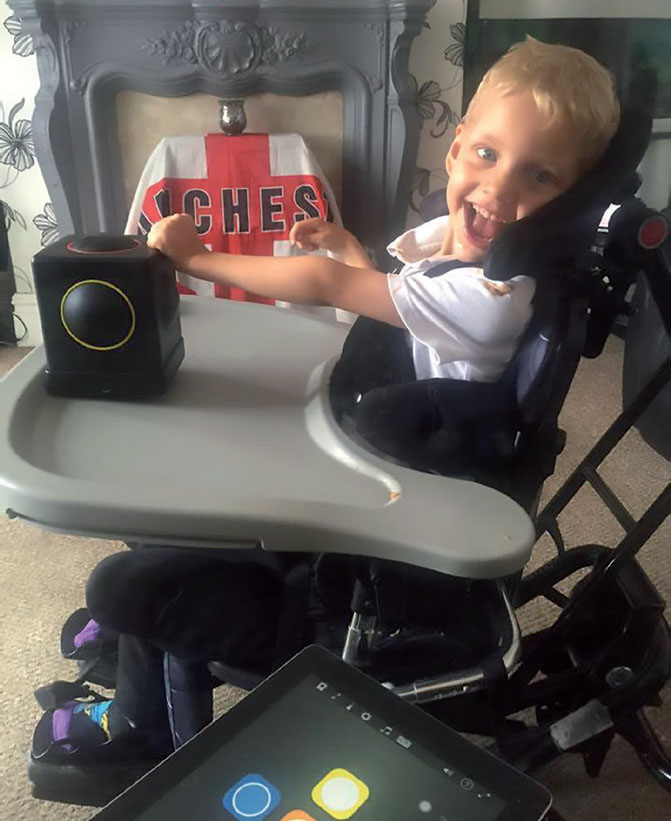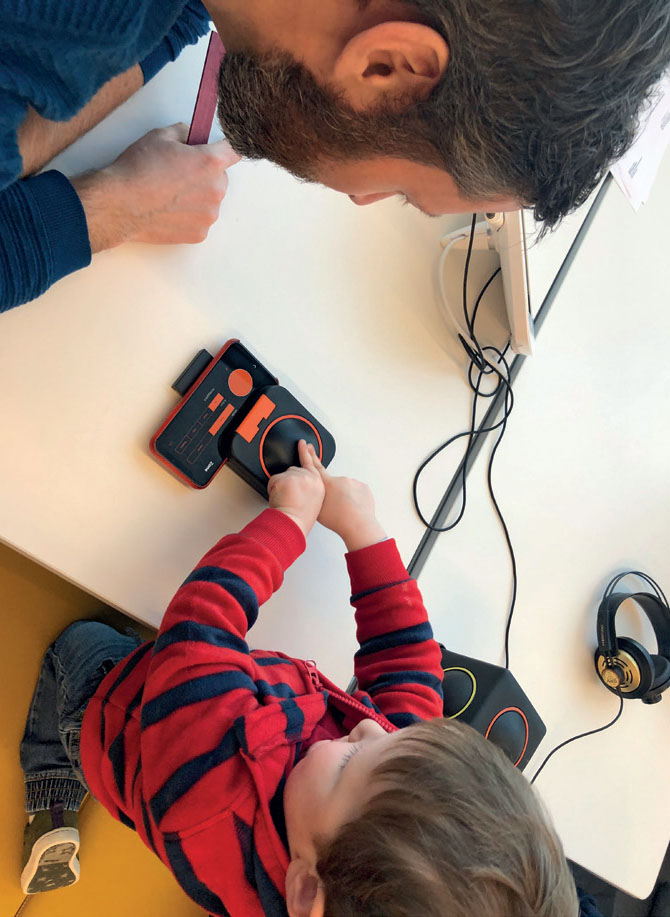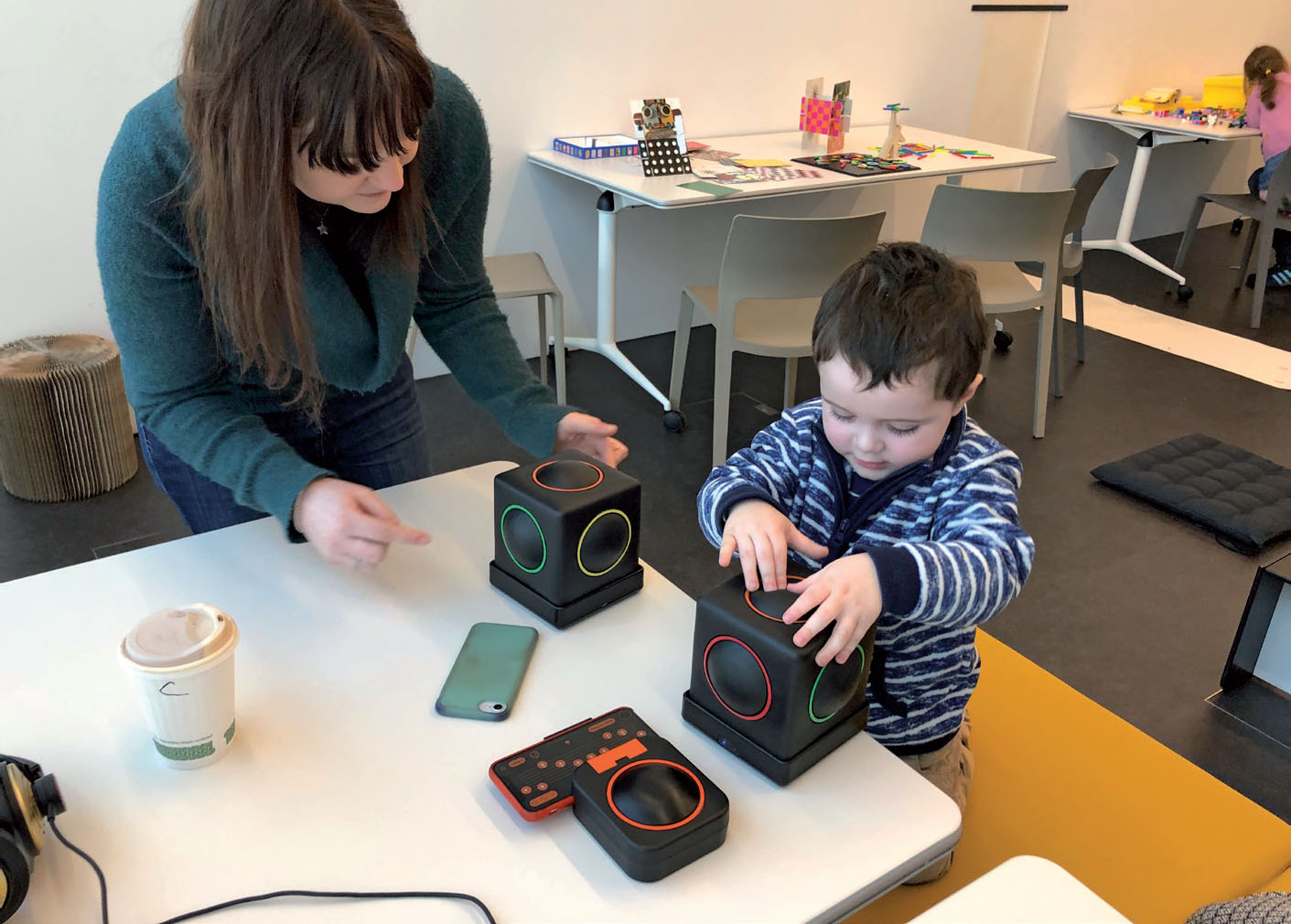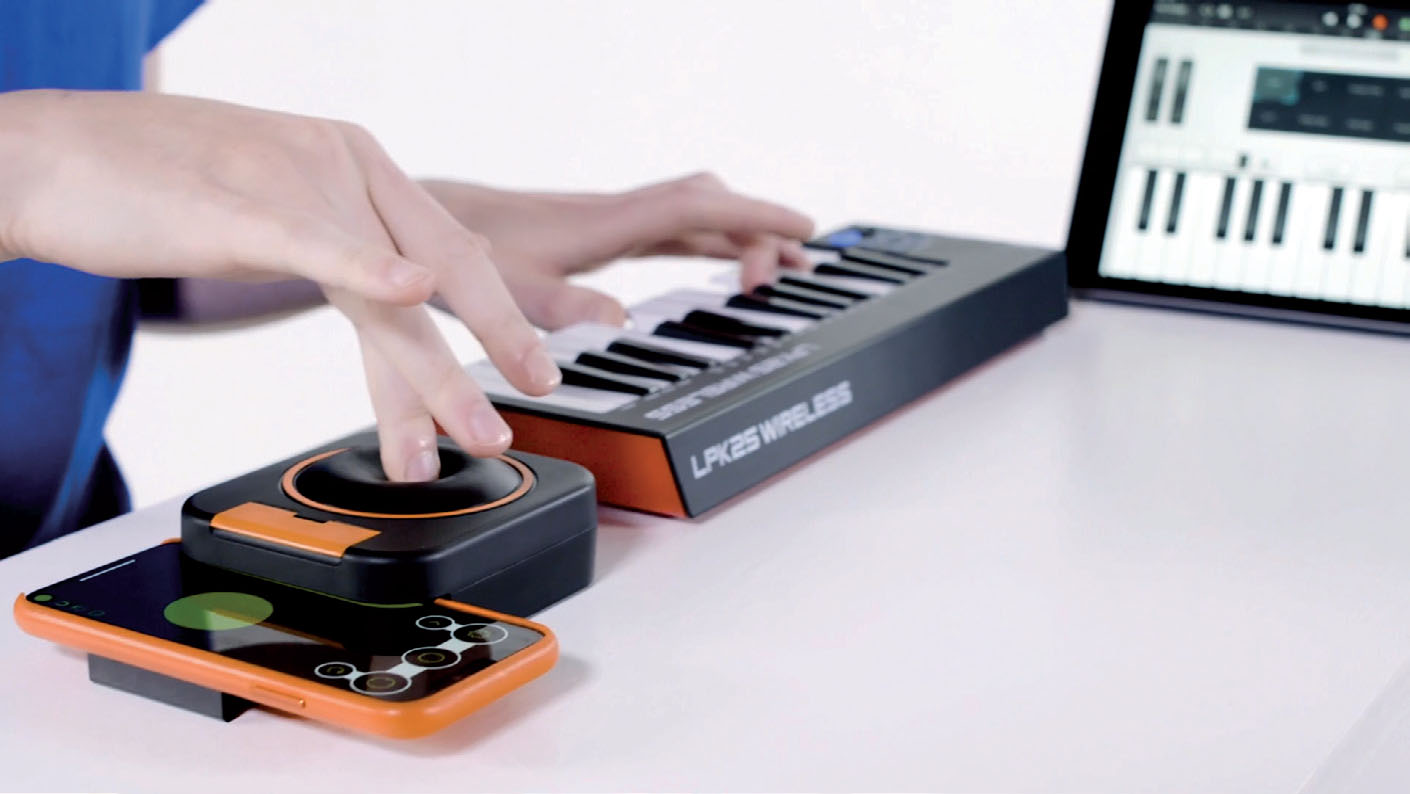
Perhaps unwisely, I've invited Julian Cow, the commercial director of Skoogmusic, to visit the office when we're in the middle of moving. ‘It's just like my daughter's bedroom,’ he says, as we step around the boxes and crates that have come to dominate the space. Once we make it to the meeting room, he begins to set up for a demonstration and we make small talk – it turns out that we're both flautists.
The Skoog is the brainchild of David Skulina and Ben Schögler, who came together in 2006 through a research project at the University of Edinburgh that was designed to remedy the dearth of traditional musical instruments that could be used by disabled people. Skulina studied Physics with Music and has a PhD in Musical Acoustics, while Schögler has a PhD in Developmental Psychology. By 2008, they had a prototype instrument that would come to market just two years later as the Skoog.
My background is in teaching music to young disabled people so I'm quite keen to find out more about the Skoog and its recently arrived sibling, the Skwitch. Cow starts by explaining that the guiding philosophy of the company can be summed up in three words: music, accessibility and coding. It is these three pillars that he's keen to show as he brings out the Skoog 2.0.
Skoog 2.0
As the name suggests, this is the second iteration of the Skoog and it retails at £179.95. The new version is black where its predecessor was white, and is completely wireless (save for when it's charging) where the original needed to be connected via USB. The buttons have also been redesigned, black and with a halo of colour around the base of each one as opposed to the first Skoog's uniform colours. It looks very impressive and Cow shows me how the base, which is suitably solid, has a series of raised dots on one side of it so that someone with visual impairments knows how to position the Skoog, with the red button facing them.
The team has also worked to ensure that the instrument can be connected to mounting systems to enable it to be positioned more accessibly for all users as necessary.

The Skoog is much more inclusive than traditional instruments
Getting started
Cow talks me through the setup process, which just means turning on the Skoog, opening up the Skoog app and connecting the Skoog as a Bluetooth device. The screen shows the faces laid out in a cross shape and Cow shows me how easy it is to change the type of instrument the Skoog synthesizes, how to change the key or which note each face plays, and even how to change the sensitivity threshold of each individual face. The changes are instantaneous, though there's a calibration button in case things get a little confused.
This latter option means that you could have the buttons which are furthest from the player require less effort to produce a sound. This is a very good way of accommodating people with physical disabilities. It also makes the Skoog very useful for music therapy (page 21), providing a metric by which a patient can be measured. The fact that they are also playing music means that they can feel more engaged with treatment.
I'm then shown the inbuilt songbook – consisting of nursery rhymes, Christmas carols and so on – and told to pick one. I go for that timeless classic ‘Incy Wincy Spider’. The screen shifts to show a line of coloured dots, varying in length to indicate how long I should hold the button. I get stuck in and play the whole song. I found it to be very intuitive and easy to play. As I finish, Cow nods to our shared instrument when he says: ‘We couldn't have gotten someone to play that on a flute so soon after laying their eyes on it for the first time.’
I'm in awe and joke to Cow that I'm going to add Skooger to my CV. ‘Please do,’ he says. ‘That's what we want to see.’ In addition to the songbook, the company produces a number of online resources for the Skoog and the Skwitch on its website.
One other impressive feature Cow demonstrated was the iTunes and Spotify library integration, this allowed me to play along with songs in the iTunes library. The Skoog app automatically tuned itself to match the key of the song, allowing me to improve along with the track.
Built to last
I know that while my former students would love the Skoog, many of them have profound disabilities and would simply not be able to be mindful of how they interact with it. I ask Cow how robust the Skoog is, and he responds by wordlessly sweeping his arm across the table, quite forcefully, launching the Skoog into the wall. It strikes the wall hard enough to startle my colleagues on the other side before dropping to the ground with another thud. As it lies on one of its faces, a single note continues to hum until I pick it back up. I set it back on the table and have another play with it. Everything works. ‘That's how robust it is,’ he says, once the device has fallen silent.
He goes on to explain how the Skoog has passed all of the safety regulations needed in the UK need to have as a way to guarantee its suitability for children. This isn't to say that the Skoog is a toy, but it does again show just how committed the company is to its pillar of accessibility. It also wipes clean, so keeping it looking its best shouldn't be a problem.

At work on their next Skwitch masterpiece
Wonder box
As mentioned previously, the Skoog connects to the iPad as a Bluetooth MIDI device, which means that it can be used by a number of other apps, such as GarageBand, massively increasing the pool of possible sounds and instruments.
As well as this compatibility with other software, there are a few other apps from Skoogmusic that Cow runs through with me. First there's Skoog Skratch, an audio sampling app, which allows you to record up to five sounds and mix things up a bit by using the buttons to scratch away at your Skoog like a DJ. Then there's Skoog Access, which turns the Skoog into a communication assistant. Each of the five buttons can be programmed to say a phrase in a number of different languages using Apple's own synthesised voices, which sound surprisingly natural. The on-screen buttons can each be assigned an image so that, for example, you could set an image of a glass of water to the orange button, which has also been programmed to say the phrase ‘I am thirsty’. Then, when the user is thirsty, they can simply press the orange button on their Skoog and communicate their needs. I'm very impressed by this – my auntie is bedridden with multiple sclerosis, and this simple setup could empower her so that she can make sure her basic needs are being met.
Lastly, I'm taken through the final pillar of the Skoog by being introduced to the Swift Playgrounds app, which is where you can learn to code using Apple's own coding language, Swift. Skoogmusic has produced a number of resources for the Playground which see the Skoog used in a number of amazing ways. Cow shows me a little program that allows him to use the Skoog to control a small ball that he sends whizzing about the table. With a bit of time and knowledge, you could even write a program that would change the set of notes on the Skoog after a certain amount of presses, allowing you to change keys midway through a song. Leaving me facing the endless opportunities that this opens, Cow puts the Skoog away and brings out the Skwitch.

Its simple design means that even small hands can make big sounds with the Skoog
Skwitch
The Skwitch is a bit different though has much of the same utility as the Skoog, coming in at just under £45. Instead of five faces, there is a single button that clips fimly onto an iPhone. Cow jokingly refers to the set-up process as magic. The device needs to be lined up with an outline on the screen and once everything goes green, we're good to go.
Like the Skoog, the Skwitch is clearly a robust product though, as Cow points out, the fact that it needs to be attached to an iPhone means that throwing this across the room is probably going to more of an issue – though the Skwitch would survive!
While there is only the single button, it is possible to tell the app to read it as four different inputs by splitting the button into between two and four segments – this causes no change to the Skwitch itself so it might take some time to figure out exactly where the different areas begin and end.
The Skwitch app lets you compose your own piece of music by placing notes onto a custom stave, which can then be played through by pressing the Skwitch. There's an option that allows you to customise how the app interprets each push – either as a held note or playing through the whole piece, the speed of which can also be altered, mapped to the pressure.
As with the Skoog, the Skwitch can also be used a control device for other apps and remote-control devices, opening up an entire world of music and technology to children from an early age.
In summary
The company is aware of the limitations placed on the instrument by its reliance on expensive Apple products – the Skwitch will only work on the iPhone 6S and upwards, which turns its low price tag into something much higher. Cow explains that it is the stability and uniformity of iOS that makes integrating with the hardware much simpler and guarantees the same user experience for everyone, everywhere. It's an understandable tradeoff, especially when one of the things that you are promoting is accessibility. That said, if Skoogmusic was to launch Android apps, I'd buy both pieces of hardware in a snap – and I'm sure I wouldn't be alone.
With these products, Skoogmusic is already changing the way in which all people can make music. I have a firm belief that music education, indeed education generally, needs to adapt to people's needs and not demand that people change to fit the world as it currently exists. Products like these show that such a system is entirely possible – it just needs music educators to embrace the change.

The Skwitch can be used like any other Bluetooth MIDI device




